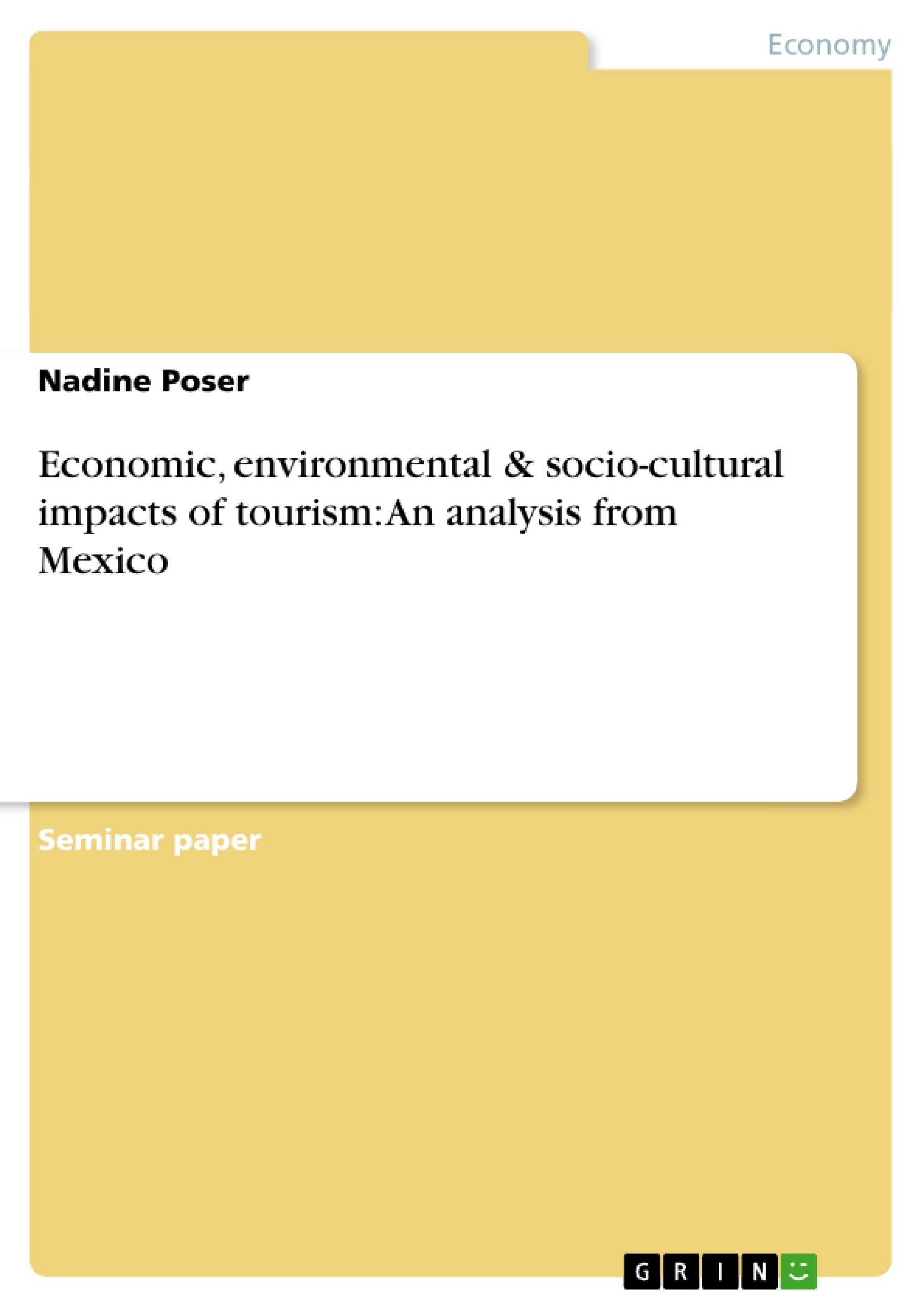Tourism industry has evolved to a leading economic factor for many countries.
According to the World Tourism Organization, tourists are people who "travel to and stay in places outside their usual environment for not more than one consecutive year for leisure, business and other purposes not related to the exercise of an activity remunerated from within the place visited" (UNWTO, 2007). The agency examined that there were over 846 million international tourist arrivals in 2006. The industry has become essential for many countries.
Tourism generates different kinds of revenue that can contribute to the host country’s welfare. Further, with the development of resorts, jobs are created in sectors directly or indirectly related to tourism such as transportation, accommodation and entertainment services. The following report investigates economic, environmental and socio-cultural impacts in Mexico caused by the tourism industry. Positive as well as negative influences will be investigated. Furthermore, the paper will have a special focus on Cancún, a mega resort built by a governmental agency within only a few years. Mexico accounts to the leading tourism destinations among developing countries. Despite its wonderful beaches and the different kinds of activities such as water sports, deep-sea fishing, diving Mexico offers a wide range of culture and history. Ancient Maya sites, for example Tulum or Chichen Itza being the most popular attraction with tourists.
Table of Contents
- Introduction
- Main Paragraph
- Economic Impacts
- Environmental Impacts
- Socio-Cultural Impacts
- Conclusion
Objectives and Key Themes
This report investigates the economic, environmental, and socio-cultural impacts of the tourism industry in Mexico, focusing specifically on Cancún as a case study. The analysis examines both the positive and negative consequences of tourism's growth, providing a comprehensive overview of its multifaceted effects on the Mexican economy and society.
- Economic impacts of tourism in Mexico
- Environmental consequences of tourism development
- Socio-cultural changes resulting from tourism
- The role of Cancún as a major tourist destination
- The relationship between tourism and local communities
Chapter Summaries
Introduction: This chapter introduces the geographical context of Mexico, highlighting its location and demographics. It then focuses on Cancún, detailing its location, infrastructure, and popularity as a tourist destination. The introduction establishes Cancún's significance within the broader context of Mexican tourism, emphasizing its economic contribution and role as a leading tourist destination globally and within Latin America. The chapter highlights Mexico's strategic advantage due to its proximity to the U.S. and the booming tourism industry, supported by statistics on tourist arrivals and hotel occupancy rates.
Economic Impacts: This section analyzes the significant positive economic impacts of tourism in Mexico, primarily focusing on direct revenue generation from tourist activities. The chapter presents data illustrating the growth of international tourism receipts and their contribution to the GDP. It differentiates between direct taxes levied on tourists and those imposed on tourism businesses. Furthermore, it examines the impact on employment, demonstrating the significant number of jobs directly and indirectly created by the industry and highlighting the multiplier effect on local economies. It discusses the relationship between larger hotels and local suppliers, noting the challenges and limited extent of direct contracts with local businesses due to factors like mistrust and cultural differences.
Keywords
Tourism, Mexico, Cancún, economic impact, environmental impact, socio-cultural impact, sustainable tourism, GDP, employment, local communities, mega-resort, tourism receipts.
Frequently Asked Questions: Comprehensive Language Preview of Tourism in Mexico
What is the overall topic of this document?
This document provides a comprehensive overview of the impacts of tourism in Mexico, using Cancún as a primary case study. It analyzes the economic, environmental, and socio-cultural consequences of tourism development, examining both positive and negative effects.
What are the key themes explored in the document?
The key themes include the economic impacts of tourism (revenue generation, employment, GDP contribution), the environmental consequences of tourism development, the socio-cultural changes resulting from tourism, the role of Cancún as a major tourist destination, and the relationship between tourism and local communities. The analysis focuses on the multifaceted effects of tourism's growth on the Mexican economy and society.
What aspects of the economic impact of tourism are discussed?
The economic impact analysis covers direct revenue generation from tourist activities, the contribution of tourism to the GDP, the impact on employment (both direct and indirect jobs), and the multiplier effect on local economies. It also addresses the relationship between larger hotels and local suppliers, noting challenges in direct contracting with local businesses.
What are the main points covered in the chapter summaries?
The introduction sets the geographical context, focusing on Mexico and Cancún's location, infrastructure, and significance as a global and regional tourist destination. The economic impacts chapter analyzes the positive economic contributions of tourism, including revenue generation and employment. Further chapters (implied but not fully detailed in the preview) would presumably delve into environmental and socio-cultural impacts.
What is the role of Cancún in this analysis?
Cancún serves as a primary case study to illustrate the effects of tourism in Mexico. Its significance as a major tourist destination, its infrastructure, and its relationship with the local communities are central to the analysis.
What keywords are associated with this document?
Keywords include Tourism, Mexico, Cancún, economic impact, environmental impact, socio-cultural impact, sustainable tourism, GDP, employment, local communities, mega-resort, and tourism receipts.
What is included in the Table of Contents?
The table of contents includes an Introduction, a main paragraph (broken down into sections on Economic, Environmental, and Socio-Cultural Impacts), and a Conclusion.
What is the stated objective of the report?
The report aims to investigate the economic, environmental, and socio-cultural impacts of the tourism industry in Mexico, focusing on Cancún to provide a comprehensive understanding of its multifaceted effects on the Mexican economy and society.
- Quote paper
- Nadine Poser (Author), 2008, Economic, environmental & socio-cultural impacts of tourism: An analysis from Mexico, Munich, GRIN Verlag, https://www.grin.com/document/116677




